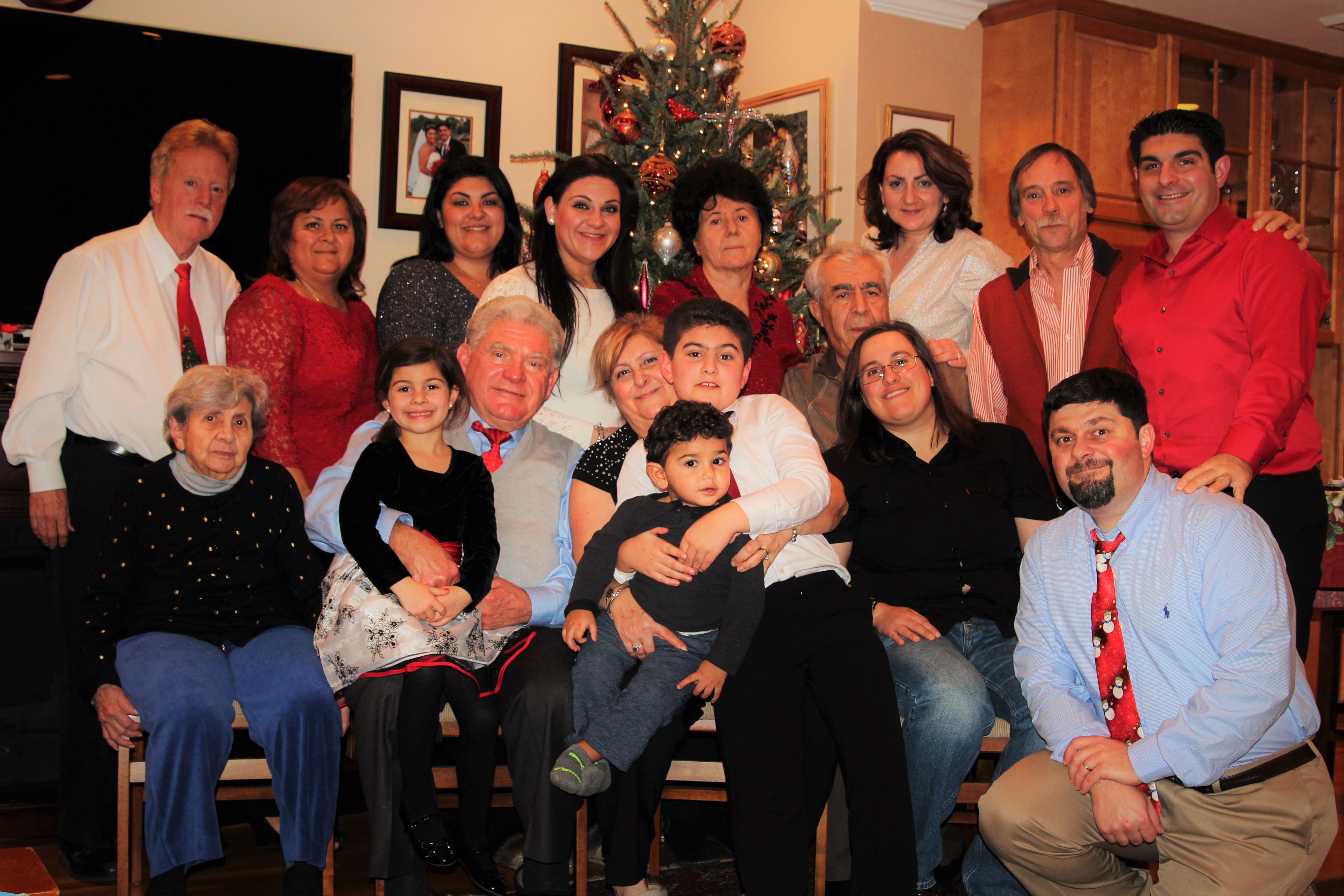Louisa (Kalikian) Kazandjian was born in 1921 in Bucharest, Romania. She was the oldest child of Hagop and Haigui (Artinian) Kalikian. She died peacefully, surrounded by loved ones, at the Armenian Nursing & Rehabilitation Center in Boston, Mass. on February 12, 2019, at 97 years of age.

The story of Louisa Kalikian Kazandjian’s life, like that of many Armenians born near the turn of the twentieth century, spans continents and cultures. Her parents’ families both hailed from Western Armenia, then a part of the Ottoman Empire. As ethnic persecution grew in the region, it became less safe for Armenians, and both families fled, at different times, to Romania.
Louisa’s parents, Hagop and Haigui, met and married in Bucharest, where Louisa was born in 1921. They joined a robust and growing working class Armenian population forming in the city. Armenians are, if anything, a resilient people, and this community, like the other pockets of Diasporans across the globe, built a vibrant network of churches, schools and specialty shops.

These were relatively peaceful times for the Kalikian family. Louisa’s parents made their livelihood running a grocery store in a suburb of Bucharest, and from 12 years old until she was 22, Louisa worked there alongside her two younger brothers, Garabed and Aram. She was introduced to European history and art by her mother and educated about the homeland by her father. The children grew up hearing many stories about the “Old Country,” the history of her people, as well as the genocide that had forced them to flee. During this time, Louisa attended Armenian school in Romania, where she was taught to love and cherish her heritage, culture and mother tongue. Her teacher was the late Catholicos of All Armenians, Vazgen I.
When she was 14 years old, Louisa’s father suffered a massive stroke and was unable to continue managing the family store. Though she had many interests and loved going to school, Louisa was forced to abandon her education after the eighth grade and assume many adult responsibilities, so that her family might survive.
The 1940s were a time of great tragedy in world history, and sadly, the Kalikian family was no exception. In 1943, seven years after his stroke, Louisa’s father died. Soon after, her brother Garabed succumbed to pneumonia—a death which could have been avoided had the family had access to penicillin. She hardly had any time to grieve, when a bone infection took her mother, as well—another death preventable by penicillin. Louisa would later recall this painful time of her life to her children, sharing with them her many fruitless journeys out into the freezing cold in search of the now-ubiquitous drug that could have saved both her brother and mother. By 1945, Louisa, now aged 24, had only her youngest brother, Aram.
After World War II, Romania gave way to Sovietization. Private ownership became illegal, and the Kalikians’ beloved family grocery store was no longer profitable. Louisa’s brother was making plans to leave—but where would they go? The silver lining of the Armenian Genocide was that it had dispersed their family across the globe. As a result, they had relatives and connections in far flung places, from Armenia to Argentina; they needed but to take their pick.
During this time, the Soviet Union was beginning to disseminate propaganda in the hopes of bolstering its citizenship and expanding its workforce to help with reconstruction following World War II. By November of 1945, Stalin had authorized the return of Ottoman Armenians to Soviet Armenia. The mass propaganda, facilitated by Armenian nationalist organizations abroad, attracted Diasporans all across Europe and the Americas to repatriate to their ancestral homeland—or what was left of it. Responding to this patriotic call, in 1948, Louisa’s brother determined the duo would venture to Armenia. They became part of the 150,000 Armenians who heeded the call of Soviet-era repatriation. But these starstruck patriots were in for a rude awakening. The propaganda had downplayed the reality that Armenia was now a Soviet-dominated country in a state of extreme poverty, which thanks to Stalin’s iron fist, doled out severe punishment to any voices of dissent. Furthermore, outsiders were less than welcome. Discrimination was not uncommon against this new-coming “akhpar” population (as they were tauntingly called by locals).
Despite these formidable obstacles, Louisa’s brother, who had been trained by a well-known jeweler back in Bucharest, quickly found work in Yerevan. In fact, he and a group of fellow Diasporan jewelers became the first to establish a state-run jewelry-manufacturing factory in Armenia.

Life in Soviet Armenia was not easy, but Louisa and her brother found companionship in a community of Romanian-Armenian expats. This was how she met her future husband, Kurken Kazandjian. Kurken, a master electrician, made a good living for their family and together, they shared in a nice apartment in Yerrort Mas (Third District), with their two daughters, Haigui and Araxie. They were comfortable in Yerevan, as Kurken’s work afforded him a decent status in Soviet society. The family was even given a telephone—a rare privilege—so that Kurken could be reached by the factory in case of an emergency. But the repression of expression and the memory of Stalin’s regime had scarred them. Kurken began looking westward, hoping to one day join his brother Dikran in the United States.
It was the sixties, and the Cold War was in full, frigid swing. Relations between the U.S. and the Soviet Union were tense, but oddly, the Kazandjians’ desire to leave came at just the right time. The USSR was facing great scrutiny from international powers, particularly those in the West, who feared the expansion of communism. In the early seventies, the Helsinki Final Act was signed, which mandated that any citizen of the Soviet Union who wished to reunite with family members in the West should be permitted to do so. The Kazandjians submitted a request to join Dikran Kazandjian in Lynn, Massachusetts and to their elation, it was granted in 1973. Louisa, Kurken and their two daughters bid farewell to their cozy, one-bedroom apartment in Yerevan to begin a new life in Lynn. Nearly fifty years later, Louisa’s daughter and granddaughter would travel to this very apartment once more, to find that the people to whom they had handed over the keys back in 1973 were still living there, and remembered them.
Life in America was extremely harsh at first, and the family wondered if they had made the right decision. But eventually, Kurken found work, and the situation improved. Louisa, for her part, also found work in the assembly line shoe factories that gave Lynn its reputation of shoe capital of the world for a time.
Louisa would go on to live the rest of her life in Lynn and had the great pleasure of watching her two daughters marry and have children. After the death of her husband in 1986, she devoted all her efforts to helping raise her grandchildren, and divided her time between the families of her two daughters. Her daughters remember her as the perfect wife, mother and grandmother. She was a vision of selflessness, from whom no one can remember a single word of complaint.
Louisa is survived by her devoted daughters: Haigui Beurekjian and her husband Onnig of Salem, Mass., and Araxie Vann and her husband Richard of Fairfax, Virginia. She was the loving grandmother of five grandchildren: Ara Beurekjian and his wife, Mariam; Manoug Beurekjian and his wife, Jennifer; Hasmig Pavlovic and her husband, Nebojsa; Anahid Vann; and Karine Vann and her fiancé, Vahe Markosian. She was also blessed with four great-grandchildren: Roman, Nicholas and Gianna Beurekjian and Layla Pavlovic. She was the dear sister of the late Garabed Kalikian, Aram Kalikian and her late sister-in-law Vasselika Kalikian. She also leaves behind her two nephews: Hagop Kalikian and his family from Nevada; and Varoujan Kalikian and his family from Maryland.

Visiting hours will be held at the Giragosian Funeral Home, 576 Mt. Auburn St. (Rt. 16), Watertown on Friday 5 to 8 p.m. Services will be held at St. Stephen’s Armenian Apostolic Church, 38 Elton Avenue, Watertown on Saturday, February 16 at 10:30 am. Interment will take place at Greenlawn Cemetery, Salem. Relatives and friends are respectfully invited to attend. Donations may be made in her memory to St. Stephen’s Armenian Apostolic Church or to the Armenian Women’s Welfare Association, 435 Pond Street, Jamaica Plain, MA 02130.



It was fantastic story of lady in fact brave lady.
A heart Warming story. A Salute to many Louisas and their families.
RIP. Good on her for all these accomplishments- raising healthy kids and grandkids, adapting to so many life changes, and living such a long and full life.